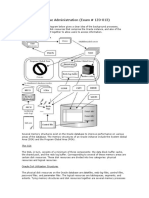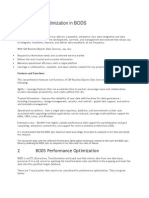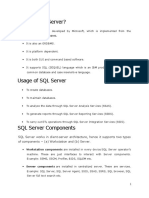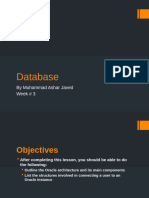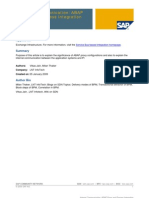Oracle BI Server Query Cache
Uploaded by
rampradeep17Oracle BI Server Query Cache
Uploaded by
rampradeep171.
About the Oracle BI Server Query Cache
Oracle BI Administrators can configure the Oracle BI Server to maintain a local, disk-based cache of query result sets (query cache). The query cache allows the Oracle BI Server to satisfy many subsequent query requests without having to access back-end databases (such as Oracle or DB2). This reduction in communication costs can dramatically decrease query response time. As updates occur on the back-end databases, the query cache entries can become stale. Therefore, Oracle BI Administrators need to periodically remove entries from the query cache using one of the following methods:
Manually. In the Administration Tool, in the Manage menu, select Cache to open the Cache Manager. Cache Manager provides the maximum flexibility in choosing which cache entries to purge and when to purge them, but it requires direct human involvement. For more information, refer to Using the Cache Manager.
Automatically. In the Administration Tool, you can disable cache for the system, set caching attributes for a specific physical table, and use Oracle BI event tables to purge cache automatically. For additional information about managing cache, Section 2.
Programmatically. The Oracle BI Server provides ODBC-extension functions for purging cache entries programmatically. These functions give you the choice and the timing flexibility of Cache Manager with the automation of event tables. You can write your own scripts to call these functions at times that fit your needs. For more information, refer to Purging and Maintaining Cache Using ODBC Procedures. The parameters that control query caching are located in the NQSConfig.INI file described in Oracle Business Intelligence Infrastructure Installation and Configuration Guide. NOTE: For information about how to use Delivers to seed the Oracle BI Server Cache, refer to Oracle Business Intelligence Presentation Services Administration Guide.
Advantages of Caching
The fastest way to process a query is to skip the bulk of the processing and use a pre computed answer. Aggregate tables are examples of pre computed answers. Aggregate tables contain pre calculated results for a particular aggregation level. For example, an aggregate table might store sales results for each product by month, when the granularity of detail for the database is at the day level. To create this aggregate table, a process (often a query) computes the results and then stores them in a table in the database. With query caching, the Oracle BI Server stores the pre computed results of queries in a local cache. If another query can use those results, all database processing for that query is eliminated. This can result in dramatic improvements in the average query response time. In addition to improving performance, being able to answer a query from a local cache conserves network resources and processing time on the database server. Network resources are conserved because the intermediate results do not have to come over the network to the Oracle BI Server. Not running the query on the database frees the database server to do other work. If the database uses a charge back system, it could save money in the budget as well. Another benefit of using the cache to answer a query is savings in processing time on the Oracle BI Server, especially if the query results are retrieved from multiple databases. Depending on the query, there might be considerable join and sort processing in the server. If the query is already calculated, this processing is avoided, freeing server resources for other tasks. To summarize, query caching has the following advantages:
Dramatic improvement of query performance. Less network traffic. Reduction in database processing and charge back.
Reduction in Oracle BI Server processing overhead.
Query Cache Architecture
The query cache consists of cache storage space, cache metadata, and cache detection in query compilation. The process of the Oracle BI Server accessing the cache metadata is very fast. If the metadata shows a cache hit, then the bulk of the query processing is eliminated, and the results are immediately returned to the user. The process of adding the new results to the cache is independent of the results being returned to the user; the only effect on the running query is the resources that are consumed in the process of writing the cached results. Query cache entries are portable across different operating systems, such as Windows or UNIX, and across 32-bit and 64-bit architectures. Incompatible cache entries are automatically removed. For example, you do not have to manually remove cache files when switching between 32-bit and 64-bit systems. Note that query cache entries are not portable across different releases of Oracle Business Intelligence, such as between Version 10.1.3.2 and 11g Release 1 (11.1.1). Caching occurs by default at the sub request level, which results in multiple cache entries for some SQL statements. Caching sub requests improves performance and the cache hit ratio, especially for queries that combine real-time and historical data. To disable sub request caching, set the NQSConfig.INI file parameter DISABLE_SUBREQUEST_CACHING to YES.
Initializing Cache Entries for User Ids
To initialize cache entries for user Ids, the Connection Pool needs to be set up for shared login with session variables VALUEOF (NQ_SESSION.PASSWORD), VALUEOF (NQ_SESSION.USER) in the login properties. If the shared login is disabled and a user specific database login is used, cache will be shared. For more information about security, refer to Security in Oracle BI.
Costs of Caching
Query caching has many obvious benefits, but also certain costs:
Disk space for the cache Administrative costs of managing the cache Potential for cached results being stale Minor CPU and disk I/O on server machine
With proper cache management, the benefits will far outweigh the costs.
Disk Space
The query cache requires dedicated disk space. How much space depends on the query volume, the size of the query result sets, and how much disk space you choose to allocate to the cache. For performance purposes, a disk should be used exclusively for caching, and it should be a high performance, high reliability type of disk system.
Administrative Tasks
There are a few administrative tasks associated with caching. You need to set the cache persistence time for each physical table appropriately, knowing how often data in that table is updated. When the frequency of the update varies, you need to keep track of when changes occur and purge the cache manually when
necessary. You can also create a cache event polling table and modify applications to update the polling table when changes to the databases occur, making the system event-driven. The Oracle BI Server also provides ODBC-extension functions for purging cache entries programmatically. You can write your own scripts to call these functions at the appropriate times.
Keeping the Cache Up To Date
If the cache entries are not purged when the data in the underlying databases changes, queries can potentially return results that are out of date. You need to evaluate whether this is acceptable. It might be acceptable to allow the cache to contain some stale data. You need to decide what level of stale data is acceptable and then set up (and follow) a set of rules to reflect those levels. For example, suppose your application analyzes corporate data from a large conglomerate, and you are performing yearly summaries of the different divisions in the company. New data is not going to materially affect your queries because the new data will only affect next year's summaries. In this case, the tradeoffs for deciding whether to purge the cache might favor leaving the entries in the cache. Suppose, however, that your databases are updated three times a day and you are performing queries on the current day's activities. In this case, you will need to purge the cache much more often, or perhaps consider not using it at all. Another scenario is that you rebuild your data mart from scratch at periodic intervals (for example, once per week). In this example, you can purge the entire cache as part of the process of rebuilding the data mart, making sure that you never have stale data in the cache. Whatever your situation, you need to evaluate what is acceptable as far as having noncurrent information returned to the users.
CPU Usage and Disk I/O
Although in most cases it is very minor, query caching does require a small amount of CPU time and adds to the disk I/O. In most cases, the CPU usage is insignificant, but the disk I/O might be noticeable, particularly if queries return large data sets.
2. Monitoring and Managing the Cache
To manage the changes in the underlying databases and to monitor cache entries, you need to develop a cache management strategy. You need a process to invalidate cache entries when the data in the underlying tables that compose the cache entry have changed, as well as a process to monitor, identify, and remove any undesirable cache entries.
Choosing a Cache Management Strategy
The choice of a cache management strategy depends on the volatility of the data in the underlying databases and the predictability of the changes that cause this volatility. It also depends on the number and types of queries that comprise your cache, as well as the usage those queries receive. This section provides an overview of the various approaches to cache management.
Disable Caching for the System
You can disable caching for the whole system by setting the ENABLE parameter to NO in the NQSConfig.INI file and restarting the Oracle BI Server. Disabling caching stops all new cache entries and stops any new queries from using the existing cache. Disabling caching allows you to enable it at a later time without losing any entries already stored in the cache. Temporarily disabling caching is a useful strategy in situations where you might suspect having stale cache entries but want to verify if they are actually stale before purging those entries or the entire cache. If you find that the data stored in the cache is still relevant, or after you have safely purged problem entries, you can safely enable the cache. If necessary, purge the entire cache or the cache associated with an entire business model before enabling the cache again.
Caching and Cache Persistence Timing for Specified Physical Tables
You can set a cacheable attribute for each physical table, allowing you to specify if queries for that table will be added to the cache to answer future queries. If you enable caching for a table, any query involving the table is added to the cache. All tables are cacheable by default, but some tables may not be good candidates to include in the cache unless you use the Cache Persistence Time settings. For example, perhaps you have a table that stores stock ticker data that is updated every minute. You could use the Cache Persistence Time settings to purge the entries for that table every 59 seconds. You can also use the Cache persistence time field to specify how long the entries for this table should be kept in the query cache. This is useful for data sources that are updated frequently.
To set the caching attributes for a specific physical table In the Physical layer, double-click the physical table. In the Physical Table properties dialog box, in the General tab, make one of the following selections: To enable caching, select the Make table cacheable check box. To prevent a table from ever being cached, clear the Make table cacheable check box. To set an expiration time (maximum lifetime), perform the following steps: In the Cache persistence time drop-down list, select a value. If you select Infinite or until you select a different value, the Cache Persistence time field will not be available. Complete the Cache persistence time field. Click OK.
Configure Oracle BI Server Event Polling Tables
Oracle BI Server event polling tables store information about updates in the underlying databases. An application (such as one that loads data into a data mart) could be configured to add rows to an event polling table each time a database table is updated. The Oracle BI Server polls this table at set intervals and invalidates any cache entries corresponding to the updated tables. Event polling tables can be your sole method of cache management or can be used in conjunction with other cache management schemes. Event tables offer less flexibility about choice of cache entries and the timing of purges. For more information about event polling tables, refer to Setting up Event Polling Tables on the Physical Databases.
About the Global Cache
In a clustered environment, Oracle BI Servers can be configured to access a shared cache called the global cache. This global cache resides on a shared file system storage device and stores purging events, seeding events (often generated by agents), and result sets that are associated with seeding events. The seeding and purging events are sorted by time and stored on the shared storage as a logical event queue. Individual Oracle BI Server nodes push to and pull from the logical event queue. Each Oracle BI Server still maintains its own local query cache for regular queries. Figure below depicts global caching in a clustered environment. It shows three Oracle BI Server nodes sharing a global cache. The global cache stores seeding or purging events held in a logical event queue. The arrows from Node 2 and Node 3 to the shared cache show Oracle BI Server Node 2 pushing a seeding event to the queue and Oracle BI Server Node 3 pushing a purging event to the queue. The arrows from the shared storage to each Oracle BI Server node show each node pulling from the common location. This occurs on a periodic basis and enables participating Oracle BI Server nodes to obtain updates to the logical event queue made by other Oracle BI Servers.
Figure : Global Caching
Description of "Global Caching" The Oracle BI Server node processes a seeding or purging event locally first in its caching system. It then pushes the event to the global cache on the shared storage. During the push event, the active Oracle BI Server node locks the logical event queue on the shared storage and then pushes in the seeding or purging event. If there is a conflict between seeding and purging (for example, one node wants to seed a query and another node wants to purge the same query), then the event that comes in last wins. The logical event queue in the global cache on the shared storage is composed of seeding and purging events from individual Oracle BI Server nodes. The queue is sorted according to the timestamp of the events. Hence, clocks on all Oracle BI Server nodes participating in cluster must be synchronized. Each Oracle BI Server node polls the global cache on a periodic basis for new cache entries. This polling frequency is configurable. A snapshot of the queued logical events on the shared storage is pulled back to the node and a local logical event queue is constructed and then processed.
Note: The process of populating or purging seeded caches across all Oracle BI Server nodes that participate in the cluster does not occur in real time, and the elapse of the process is affected by multiple factors, such as the predefined polling interval, network bandwidth, and CPU loads. Because the query cache result set tends to get large, network bandwidth might pose a constraint. Therefore, the following must be chosen carefully:
The set of caches that qualify for seeded cache The time interval for BI nodes to pick up seeded caches from shared storage (to avoid network congestion)
The primary global cache parameters are configured in Fusion Middleware Control. Additional, optional parameters are configured in the NQSConfig.INI file for each Oracle BI Server node that participates in the cluster. For more information about configuring these parameters, see "Using Fusion Middleware Control to Set Global Cache Parameters" and "Manually Editing Additional Global Cache Parameters." A seeding or purging procedure is submitted to a specific Oracle BI Server node. If that Oracle BI Server is a node in a BI cluster and the global cache parameters have been defined in Oracle BI Server configuration files, then the seeding or purging events are propagated across all Oracle BI Server nodes that participate in the same clustered environment.
You might also like
- Question & Answers: Certified in Cybersecurity (CC)100% (4)Question & Answers: Certified in Cybersecurity (CC)6 pages
- Google - Cloud Digital Leader.v2023 06 22.q106No ratings yetGoogle - Cloud Digital Leader.v2023 06 22.q10650 pages
- Quick Oracle 9i Performance Tuning Tips & ScriptsNo ratings yetQuick Oracle 9i Performance Tuning Tips & Scripts7 pages
- Database Tuning: Definition - What Does Workload Mean?No ratings yetDatabase Tuning: Definition - What Does Workload Mean?27 pages
- Oracle Database Oracle Instance + Data Files: AsktomNo ratings yetOracle Database Oracle Instance + Data Files: Asktom5 pages
- Solutions For Improving Data Extraction From Virtual Data WarehousesNo ratings yetSolutions For Improving Data Extraction From Virtual Data Warehouses10 pages
- Oracle 8: Database Administration (Exam # 1Z0-013) : The SgaNo ratings yetOracle 8: Database Administration (Exam # 1Z0-013) : The Sga16 pages
- Chapter - 1: Oracle Architecture - Module 1100% (1)Chapter - 1: Oracle Architecture - Module 139 pages
- See How Easily You Can Improve Performance by Using These Five Data Caching TechniquesNo ratings yetSee How Easily You Can Improve Performance by Using These Five Data Caching Techniques13 pages
- Snowflake Query Optimization Techniques SnowNo ratings yetSnowflake Query Optimization Techniques Snow13 pages
- Oracle 11g Database New Features Interview Questions and AnswersNo ratings yetOracle 11g Database New Features Interview Questions and Answers7 pages
- What Are The Best Mapping Development Practices and What Are The Different Mapping Design Tips For Informatica?No ratings yetWhat Are The Best Mapping Development Practices and What Are The Different Mapping Design Tips For Informatica?29 pages
- Test 3 - Oracle 8: Backup and Recovery (Exam # 1Z0-015) : Study Guide byNo ratings yetTest 3 - Oracle 8: Backup and Recovery (Exam # 1Z0-015) : Study Guide by31 pages
- Alter Database Backup Controlfile To Trace - PM-DB PDFNo ratings yetAlter Database Backup Controlfile To Trace - PM-DB PDF3 pages
- Oracle Server - An Oracle Server Includes An Oracle Instance and An Oracle Database.No ratings yetOracle Server - An Oracle Server Includes An Oracle Instance and An Oracle Database.9 pages
- Smartdba - Your Power Solution For Database Backup & RecoveryNo ratings yetSmartdba - Your Power Solution For Database Backup & Recovery11 pages
- Test Oracle Database 12c Presales Specialist Assessment ReviewNo ratings yetTest Oracle Database 12c Presales Specialist Assessment Review75 pages
- MMM MM M M MMMM M MMMMMMMMMMMMMMM M MM MMMMMMMMM MMMMMMMMMMMNo ratings yetMMM MM M M MMMM M MMMMMMMMMMMMMMM M MM MMMMMMMMM MMMMMMMMMMM10 pages
- Harder, Better, Faster, Stronger: Page Views CalendarNo ratings yetHarder, Better, Faster, Stronger: Page Views Calendar24 pages
- Configuring The Server For Optimal Performance: Course: Database Administration Effective Period: September 2017No ratings yetConfiguring The Server For Optimal Performance: Course: Database Administration Effective Period: September 201735 pages
- Database Administration and Management Lecture 3No ratings yetDatabase Administration and Management Lecture 320 pages
- Introduction To The Oracle Server: It Includes The FollowingNo ratings yetIntroduction To The Oracle Server: It Includes The Following11 pages
- Understanding SQL Server Memory InternalsNo ratings yetUnderstanding SQL Server Memory Internals13 pages
- Enterprise Ready Performance and Scalability: 9.1 Overview of Dynamic Query ModeNo ratings yetEnterprise Ready Performance and Scalability: 9.1 Overview of Dynamic Query Mode6 pages
- Configuration and Utilization of The OLAP Cache To Improve The Query Response TimeNo ratings yetConfiguration and Utilization of The OLAP Cache To Improve The Query Response Time18 pages
- SAS Programming Guidelines Interview Questions You'll Most Likely Be AskedFrom EverandSAS Programming Guidelines Interview Questions You'll Most Likely Be AskedNo ratings yet
- LPIC-3 Exam 306-300 Mastery: 500 Practice Questions on High Availability & Storage ClustersFrom EverandLPIC-3 Exam 306-300 Mastery: 500 Practice Questions on High Availability & Storage ClustersNo ratings yet
- How To Setup Session Timeout in Oracle BIEENo ratings yetHow To Setup Session Timeout in Oracle BIEE1 page
- Evading Microsoft ATA For Active Directory Domination: Nikhil MittalNo ratings yetEvading Microsoft ATA For Active Directory Domination: Nikhil Mittal59 pages
- Installing and Using Taskmaster Web Services: IBM Datacap Taskmaster CaptureNo ratings yetInstalling and Using Taskmaster Web Services: IBM Datacap Taskmaster Capture32 pages
- Excel Lab 4 - Pivot Tables and Charts: Reference If NeededNo ratings yetExcel Lab 4 - Pivot Tables and Charts: Reference If Needed6 pages
- ISTQB Foundation Certification Exam Q501 700100% (1)ISTQB Foundation Certification Exam Q501 70053 pages
- API Management, Integration, and DataPower Gateway Level 2 Quiz Attempt ReviewNo ratings yetAPI Management, Integration, and DataPower Gateway Level 2 Quiz Attempt Review13 pages
- Module 1 Introduction To Cyber SecurityNo ratings yetModule 1 Introduction To Cyber Security11 pages
- Question & Answers: Certified in Cybersecurity (CC)Question & Answers: Certified in Cybersecurity (CC)
- Database Tuning: Definition - What Does Workload Mean?Database Tuning: Definition - What Does Workload Mean?
- Oracle Database Oracle Instance + Data Files: AsktomOracle Database Oracle Instance + Data Files: Asktom
- Solutions For Improving Data Extraction From Virtual Data WarehousesSolutions For Improving Data Extraction From Virtual Data Warehouses
- Oracle 8: Database Administration (Exam # 1Z0-013) : The SgaOracle 8: Database Administration (Exam # 1Z0-013) : The Sga
- See How Easily You Can Improve Performance by Using These Five Data Caching TechniquesSee How Easily You Can Improve Performance by Using These Five Data Caching Techniques
- Oracle 11g Database New Features Interview Questions and AnswersOracle 11g Database New Features Interview Questions and Answers
- What Are The Best Mapping Development Practices and What Are The Different Mapping Design Tips For Informatica?What Are The Best Mapping Development Practices and What Are The Different Mapping Design Tips For Informatica?
- Test 3 - Oracle 8: Backup and Recovery (Exam # 1Z0-015) : Study Guide byTest 3 - Oracle 8: Backup and Recovery (Exam # 1Z0-015) : Study Guide by
- Alter Database Backup Controlfile To Trace - PM-DB PDFAlter Database Backup Controlfile To Trace - PM-DB PDF
- Oracle Server - An Oracle Server Includes An Oracle Instance and An Oracle Database.Oracle Server - An Oracle Server Includes An Oracle Instance and An Oracle Database.
- Smartdba - Your Power Solution For Database Backup & RecoverySmartdba - Your Power Solution For Database Backup & Recovery
- Test Oracle Database 12c Presales Specialist Assessment ReviewTest Oracle Database 12c Presales Specialist Assessment Review
- MMM MM M M MMMM M MMMMMMMMMMMMMMM M MM MMMMMMMMM MMMMMMMMMMMMMM MM M M MMMM M MMMMMMMMMMMMMMM M MM MMMMMMMMM MMMMMMMMMMM
- Harder, Better, Faster, Stronger: Page Views CalendarHarder, Better, Faster, Stronger: Page Views Calendar
- Configuring The Server For Optimal Performance: Course: Database Administration Effective Period: September 2017Configuring The Server For Optimal Performance: Course: Database Administration Effective Period: September 2017
- Introduction To The Oracle Server: It Includes The FollowingIntroduction To The Oracle Server: It Includes The Following
- Enterprise Ready Performance and Scalability: 9.1 Overview of Dynamic Query ModeEnterprise Ready Performance and Scalability: 9.1 Overview of Dynamic Query Mode
- Configuration and Utilization of The OLAP Cache To Improve The Query Response TimeConfiguration and Utilization of The OLAP Cache To Improve The Query Response Time
- Introduction to Oracle Database AdministrationFrom EverandIntroduction to Oracle Database Administration
- Oracle Recovery Appliance Handbook: An Insider’S InsightFrom EverandOracle Recovery Appliance Handbook: An Insider’S Insight
- SAS Programming Guidelines Interview Questions You'll Most Likely Be AskedFrom EverandSAS Programming Guidelines Interview Questions You'll Most Likely Be Asked
- SAS Interview Questions You'll Most Likely Be AskedFrom EverandSAS Interview Questions You'll Most Likely Be Asked
- LPIC-3 Exam 306-300 Mastery: 500 Practice Questions on High Availability & Storage ClustersFrom EverandLPIC-3 Exam 306-300 Mastery: 500 Practice Questions on High Availability & Storage Clusters
- Evading Microsoft ATA For Active Directory Domination: Nikhil MittalEvading Microsoft ATA For Active Directory Domination: Nikhil Mittal
- Installing and Using Taskmaster Web Services: IBM Datacap Taskmaster CaptureInstalling and Using Taskmaster Web Services: IBM Datacap Taskmaster Capture
- Excel Lab 4 - Pivot Tables and Charts: Reference If NeededExcel Lab 4 - Pivot Tables and Charts: Reference If Needed
- API Management, Integration, and DataPower Gateway Level 2 Quiz Attempt ReviewAPI Management, Integration, and DataPower Gateway Level 2 Quiz Attempt Review

















